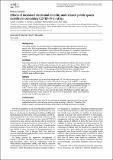| dc.description.abstract | Background
The rising COVID-19 crisis threatens to disproportionately hit African countries. As a
result, most African governments have temporarily closed schools and non-essential
businesses or banned social gatherings to contain the disease. It is therefore important to
estimate the level of transmission reduction as a result of these measures. This study
aimed at predicting COVID-19 cases in Africa based on COVID-19 community mobility
report.
Methods
Our study focused on 26 African countries whose community mobility data were available
online. The number of daily confirmed cases for the period of February 15th, 2020 to May
29th, 2020 for each country was obtained from European Center for Disease Prevention
and Control (ECDC) COVID-19 cases geographic distribution data. Multiple linear
regression was performed to investigate the relationship between COVID-19 community
mobility and confirmed cases.
Results
The maximum public place mobility change was -38.15% with an average of -18.85%
(±3.47); residential mobility was at 23.17% with an average of 11. 268% (±1.448). The
number of confirmed cases had a significant negative correlation with residential mobility
change (r = -0.878, P<0.01) and positive correlation with public place mobility change (r =
0.881, P<0.05). Both mobility changes in public spaces and residential are significant
predictors of COVID-19 cases. More specifically, about 1% change in a public place and
residential mobility would result in 167 less COVID-19 daily cases, while total lockdown
would result in 581 fewer daily cases.
Conclusions
Our analysis shows that a COVID-19 containment strategy that focuses on increasing
residential mobility and reducing public spaces mobility is effective. Therefore, the
finding supports containment measures that aim to limit the movement of people. | en_US |

